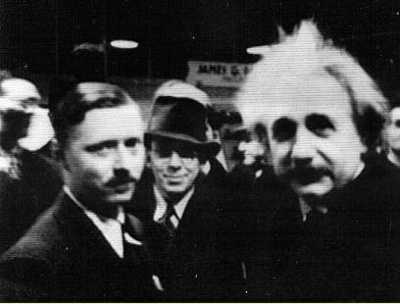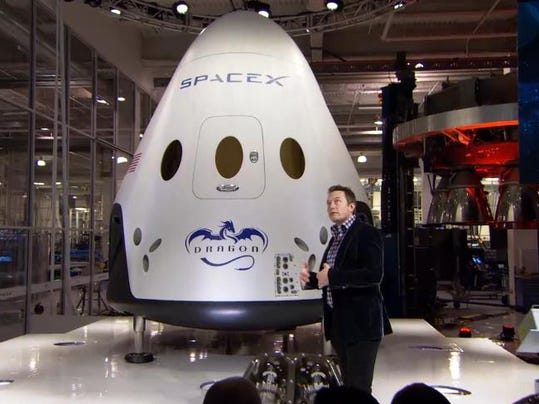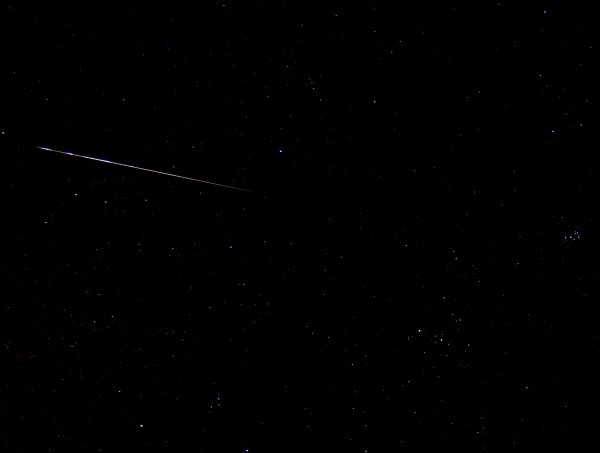
Amateur Astronomers Association of Pittsburgh (AAAP) Co-Founder
Leo J. Scanlon (left), who would later become one of the first Buhl
Planetarium lecturers, thanks Albert Einstein (right) for visiting the
AAAP booth at the 1934 convention of the American Association for
the Advancement of Science in Pittsburgh.
More Information: Link >>> http://old.3ap.org/features/leo/leoScanlonBio6.shtml
(Sources: AAAP, Scanlon Family Collection; Photo Reproduction:
© Copyright David Smith)
By Glenn A. Walsh
Reporting for SpaceWatchtower
One hundred years ago today, Physicist
Albert Einstein completely unveiled his General Theory of Relativity
before the Prussian Academy of Sciences in Berlin. It was on 1915
November 25, the fourth of a series of lectures over four consecutive
Thursdays, where he detailed the mathematical field equations that
explained and supported his General Theory of Relativity.
Dr. Einstein's General Theory of
Relativity continues today as the best explanation of gravity in
modern Physics.
Interestingly, Dr. Einstein made
revisions in his field equations, from one lecture to the next,
during the four lectures in November of 1915. Throughout this month,
he continued conferring with academic colleagues, regarding these
equations.
Until this time, scientists had relied
on Isaac Newton's Law of Universal Gravitation, which said that
gravity was a “force” that attracted two objects of mass to each
other. Hence, by this theory, the “force” of gravity, caused by
the large mass of the Planet Earth, strongly attracted all objects
found on the Earth (including us) to the Earth.
In the General Theory, Dr. Einstein
explained gravity as a warp in space-time, caused by the mass of
matter. Hence, the large mass of the Planet Earth caused such a large
warp in space-time that other objects near the Earth would simply
follow the warp, “falling” toward the Earth. By this explanation,
we (and every other object on the Earth) are simply following the
warp toward the Earth.
In the General Theory of Relativity, no gravitational force deflects objects from their natural, straight pathways. Rather, gravity corresponds to changes in space and time, which changes the straightest-possible path of an object to a possibly curved path.
With the General Theory, Dr. Einstein
also recognized that gravity and motion were equivalent. To an
observer, the pull of gravity from a planet was no different than the
pull felt by a moving rocket or a moving elevator.
The General Theory implies the
existence of Black Holes, the end of life of some of the most massive
stars. Black Holes are considered “black” because these are
regions of space where space and time are distorted to such an extent
that nothing, not even light, can escape.
The General Theory of Relativity
predicts the existence of gravity waves, which have since been
indirectly observed. As of mid-September, scientists are trying to
directly detect gravity waves, using a Laser Interferometer
Gravitational-Wave Observatory (LIGO), which uses a laser to detect
the slight changes caused by gravity waves.
Also predicted by the General Theory,
the path of light is bent, as it passes through a gravitational field
from a body of great mass, known today as gravitational lensing. To test this prediction required great
precision, as the deflection of light would be very slight. However,
no experiment on Earth would provide the accuracy necessary to
confirm the prediction.
Sir Frank Watson Dyson, Astronomer
Royal of Great Britain, proposed confirming this prediction by using
a Total Eclipse of the Sun which would occur in 1919. The May 29
eclipse would allow the observation of stars from the bright Hyades
Star Cluster, as the light from these stars passed close to the fully eclipsed Sun. With this star light
passing so close to the Sun, the Sun's gravitational field would
deflect the star light, and accurate measurements of this deflection
could be performed.
English Astronomer Sir Arthur Eddington
agreed to make the observations necessary to confirm this prediction.
He first measured the “true” positions of the stars in January
and February of 1919. In May, he observed the eclipse from the remote
island of Principe, in the Gulf of Guinea off of the west coast of
Africa. He also sent a second expedition to observe the eclipse from
Sobral, Brazil, in case the African site was clouded-out during the
eclipse.
Good observations of the eclipse were
made from both locations. Sir Eddington announced his findings,
confirming Dr. Einstein's General Theory of Relativity, on 1919
November 6. Until then, a young, fairly unknown physicist, the next
day Albert Einstein was on the front page of newspapers around the
world!
An often told story is when a student
of Dr. Einstein asked about the possibility the solar eclipse would
not confirm the General Theory. Dr. Einstein, who often was convinced
of a theory without experimental evidence, was reported by the
student to have said, “Then I would have been sorry for the dear
Lord. The theory is correct.”
However, University of Winnipeg History
Professor David R. Topper, in his 2007 book, Quirky Sides of
Scientists, reports that this
quote is probably a myth. Dr. Topper writes, “In a meticulously
researched study of the story, Klaus Hentschel has convinced me the event
never happened, and that it was a reconstruction by the student much
later than the event (in the 1950s) to support her view that Einstein
shared her philosophical (neo-Kantian) viewpoint (which he did not).” Klaus Hentschel is a German physicist and
the head of the History of Science and Technology section of the History
Department of the University of Stuttgart.
Just ten years before the presentation
of the General Theory, Albert Einstein had unveiled his Special
Theory of Relativity, which is now an experimentally well-confirmed
physical theory regarding the relationship between space and time.
The two postulates of the Special Theory of Relativity are:
- The laws of physics are invariant in all inertial systems;
- The speed of light in a vacuum is the same for all observers, no matter the motion of the light source.
Even today, the Special Theory of
Relativity is the most accurate model of motion at any speed. And,
from the Special Theory arose the idea of mass—energy equivalence,
better known by the general public as the famous equation E = mc2.
More on the General Theory of Relativity: Link >>> https://en.wikipedia.org/wiki/General_relativity
More on the Special Theory of Relativity: Link >>> https://en.wikipedia.org/wiki/Special_relativity
More about Albert Einstein: Link >>> https://en.wikipedia.org/wiki/Albert_Einstein
More on Albert Einstein's speaking engagement at the 1934 convention of the American Association for the Advancement of Science in Pittsburgh and his meeting with the Amateur Astronomers Association of Pittsburgh: Link >>> http://old.3ap.org/features/leo/leoScanlonBio6.shtml
Photograph of Albert Einstein's desk the day before he passed-away:
Link >>> http://buhlplanetarium.tripod.com/bio/einstein/pix/Einsteindesk.jpg
Related Blog Post ---
"Laser Observatory May Directly Detect Gravity Waves." 2015 Oct. 7.
Link >>> http://spacewatchtower.blogspot.com/2015/10/laser-observatory-may-directly-detect.html
Source: Glenn A. Walsh Reporting for SpaceWatchtower, a project of Friends of the Zeiss.
Want to receive SpaceWatchtower blog posts in your inbox ?
Send request to < spacewatchtower@planetarium.cc >..
gaw
Glenn A. Walsh, Project Director,
Friends of the Zeiss < http://buhlplanetarium.tripod.com/fotz/ >
Electronic Mail - < gawalsh@planetarium.cc >
SpaceWatchtower Blog: < http://spacewatchtower.blogspot.com/ >
Also see: South Hills Backyard Astronomers Blog: < http://shbastronomers.blogspot.com/ >
Barnestormin: Writing, Essays, Pgh. News, & More: < http://www.barnestormin.blogspot.com/ >
About the SpaceWatchtower Editor / Author: < http://buhlplanetarium2.tripod.com/weblog/spacewatchtower/gaw/ >
SPACE & SCIENCE NEWS, ASTRONOMICAL CALENDAR:
< http://buhlplanetarium.tripod.
Twitter: < https://twitter.com/spacewatchtower >
Facebook: < http://www.facebook.com/pages/
Author of History Web Sites on the Internet --
* Buhl Planetarium, Pittsburgh:
< http://www.planetarium.
* Adler Planetarium, Chicago:
< http://adlerplanetarium.
* Astronomer, Educator, Optician John A. Brashear:
< http://johnbrashear.tripod.com >
* Andrew Carnegie & Carnegie Libraries:
< http://www.andrewcarnegie.
* Civil War Museum of Andrew Carnegie Free Library:
< http://garespypost.tripod.com >
* Duquesne Incline cable-car railway, Pittsburgh:
< http://inclinedplane.tripod.
* Public Transit:
< http://andrewcarnegie2.tripod.





